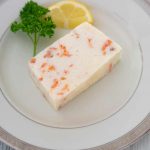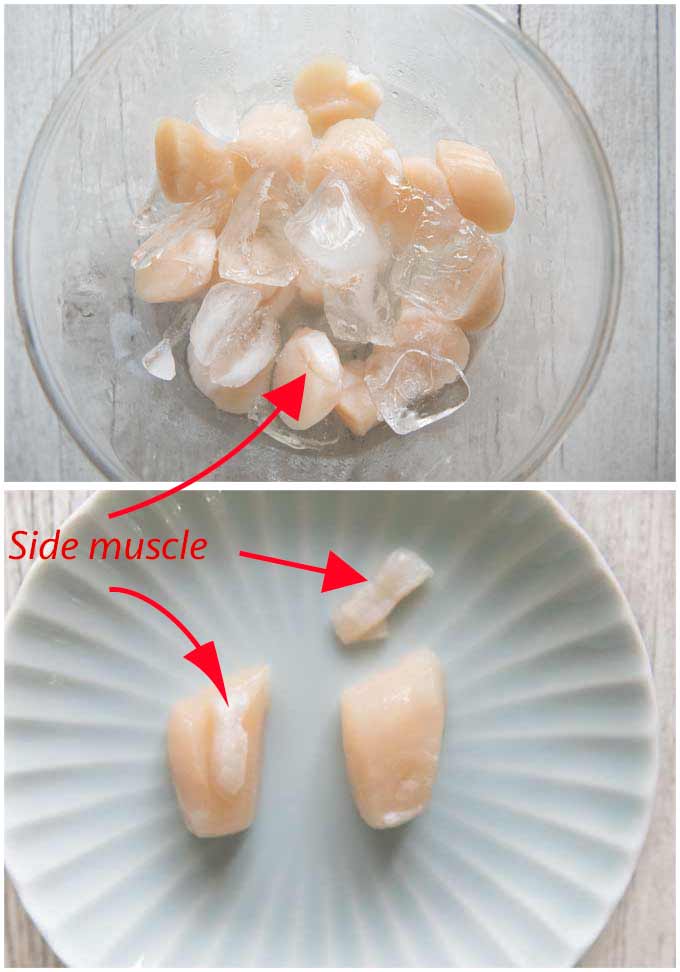
Scallop Terrine is a perfect dish for a special occasion. As soon as you put a small piece into your mouth, you will know why this is so special. The flavour of the scallops is so sensational that you can’t help blurting out ‘wow!’.
Total Time includes the time to cool it down sufficiently so that you can chill it in the fridge, but it does not include the time to chill the terrine in the fridge.
I referenced the recipe from the Japanese website sou-recipe.com.
Don't forget to see the section 'MEAL IDEAS' below the recipe card! It gives you a list of dishes that I have already posted and this recipe that can make up a complete meal. I hope it is of help to you.
- 300g / 0.7lb scallops without coral and frills, pat dried (note 1)
- 4g / 0.1oz salt
- 60g / 2.1oz egg white (about 2 eggs)
- 120ml / 4.1oz cream (note 2)
- 60ml / 2.0oz double cream (note 2)
- 70-80g / 2.5-2.8oz smoked trout slices cut into 1cm / ⅜” square pieces (note 3)
- Boiling water to fill the roasting pan/cake pan
- Sprigs of parsley
- A small 800ml / 1.7pt terrine pan/loaf pan (note 4)
- A cardboard or plastic board cut to the same dimension as the opening of the terrine pan
- 1kg / 2.2lb weight (can be a carton of juice/soup stock etc)
- A food processor (note 5)
- A spatula
- A piping bag
- A roasting pan/cake pan lined with kitchen paper (note 6)
-
Heat oven to 150°C/ 302°F.
-
Wet inside of the terrine pan, then line with foil covering long sides and the bottom, leaving a sufficient length on both ends of the foil (so that they can cover the top later).
-
Remove creases of the foil by rubbing the surface, then butter all sides and the bottom of the pan.
-
Cover the cardboard/plastic board completely with clingwrap
-
Remove the tiny side muscle from each scallop (optional, note 7).
-
Put all the scallops in the food processor and blitz until the scallops become a paste. You may need to occasionally push down the paste stuck on the side with a spatula.
-
Add salt in a few batches and blitz.
-
Add egg white, small amount at a time, while processing the paste.
-
When the egg white is well mixed and the mixture becomes smooth, add about 1/5 of the cream to the scallop paste.
-
Use a spatula to mix well. Move the spatula quickly right and left several times, trying to get air into the mixture. This will help make the soft texture of the terrine.
-
Add the remaining cream in 4 batches and mix the paste in the same way.
-
Add the smoked trout to the scallop paste and mix in a cutting motion with the spatula initially to spread the trout pieces evenly (because they are stuck), then mix well.
-
Transfer the paste to a piping bag (note 8), cut the tip of the piping bag off to make an opening of about 1cm in diameter.
-
Fill the terrine pan with the scallop paste by squeezing the paste out of the bag, filling the bottom of the pan with 3-4 strands of the paste. Avoid air pockets as much as possible.
-
Fill the pan with the rest of the paste by squeezing out the paste in the same way on top of the existing layer (I made 3 layers). Smooth the surface with the spatula or the back of a spoon.
-
Lift and drop the pan onto a work bench a few times to remove the air pockets inside the paste.
-
Fold the excess foil on both sides of the pan to cover the surface of the terrine. Then cover the pan with two layers of aluminium foil.
-
Place the terrine pan on the kitchen paper in a roasting pan/cake pan and place it on the middle shelf of the oven.
-
Add the boiling water to the outer pan as high as possible.
-
Steam bake for 40 minutes (note 9).
-
Take the terrine out of the oven, remove it from the hot water bath.
-
Place the board on top of the foil cover as if you are putting a lid on the terrine. Place a weight on it (note 10) and leave for 10-15 minutes until it cools down enough so that you can touch the pan by hand.
-
Remove the weight and the board, place the terrine pan into ice water to cool it down sufficiently so that you can put it in the fridge. Chill it in the fridge completely.
-
Remove the foil cover, lift the excess foil that was folded over the surface and transfer the terrine from the pan to a cutting board. Gently remove the foil from the terrine.
-
Cut the terrine into 6 slices and serve each slice on a plate with a sprig of parsley.
1. I used sashimi quality frozen scallops that came in a box of 500g or 1kg. These are imported from Japan. You can buy them at Japanese/Asian grocery stores and some fish shops.
There is a particular method of defrosting these sashimi quality scallops to retain flavours. It is recommended by the Japanese scallop companies. See note 11.
You can also use fresh scallops that are sold for sashimi or cooking.
2. Instead of mixing cream and double cream, you can use 180ml cream if you prefer a slightly lighter flavour.
3. As an alternative, you can use smoked salmon.
The original recipe uses fresh shrimps that are processed into a semi-paste. I found that the shrimp flavour was overpowering the delicate scallop flavour. But if you want to use shrimp instead, use 80g / 2.8oz of peeled shrimp.
4. My terrine pan was metal. The dimensions were 15cm x 9.5cm / 6" x 3¾" and 7.5cm / 3" deep. A terrine pan with different dimensions makes different size of sliced terrine.
5. Alternatively, use a stick blender with a bowl.
6. It should be large enough to comfortably place the terrine pan inside. The depth needs to be about the same as the terrine pan or deeper.
7. The original recipe suggests removing the side muscle as it is a tough piece of flesh. Removing them makes the texture of terrine marginally smoother. See the photo in Note 11.
If you are removing the tough muscles, you need to allow for extra scallops to make up to 300g.
8. Since the paste is quite thick, it is easier to fill the terrine pan with a piping bag. If you don’t have a piping bag, you can use a thick plastic bag, e.g. zip lock bag, as an alternative.
9. To check if the terrine is done, poke the centre of the terrine with a metal skewer for 5 seconds, then remove and check the temperature by putting the tip on your lips. If the tip is comfortably warm, it is done.
10. This will level the surface of the terrine. Prolonged weighting or using a heavier weight makes the terrine too dense.
11. Best way to thaw frozen sashimi quality scallops:
- Put 1½-2 cups of ice in a bowl. Sprinkle 2 teaspoons of salt over the ice.
- Place frozen scallops in the ice and cover the bowl with cling wrap.
- Leave it at room temperature for 3-5 hours (time varies depending on the size of scallops).
- When the scallop are almost thawed and the centre of the scallop is still little bit frozen, remove from the ice and pat dry with kitchen paper.

12. Nutrition per serving.
serving: 103g calories: 163kcal fat: 12g (18%) saturated fat: 7.2g (36%) trans fat: 0.4g polyunsaturated fat: 0.6g monounsaturated fat: 3.1g cholesterol: 56mg (19%) sodium: 565mg (24%) potassium: 192mg (5%) carbohydrates: 2.5g (1%) dietary fibre: 0g (0%) sugar: 0.9g protein: 12g vitamin a: 11% vitamin c: 0.3% calcium: 2% iron: 1.9%